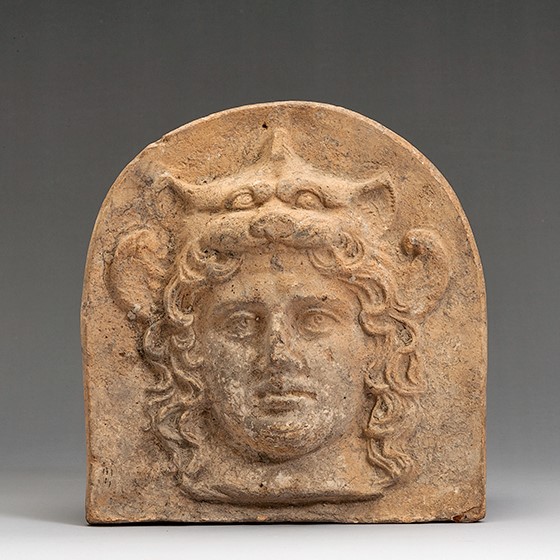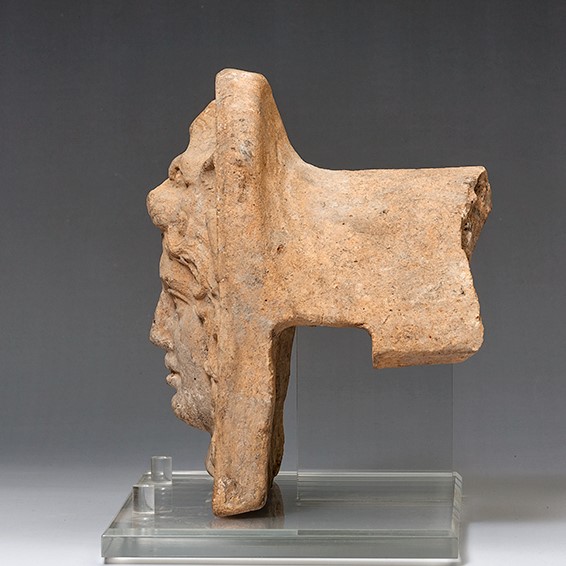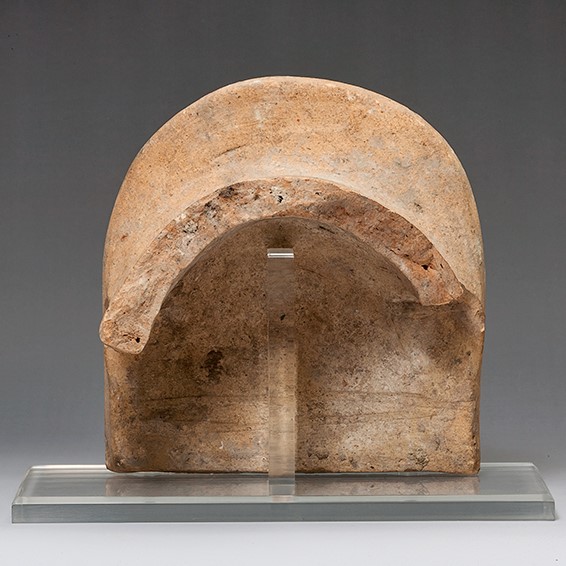Acquisition number: 1979.08
Front for a row of cover-tiles at the edge of a roof. Part of the cover-tile at the rear has been broken away, but the moulded front is intact and in good condition. Pale cream-brown clay with a number of voids and large dark inclusions. No traces of paint are preserved though the surface at the front seems to have been slipped.
The front is the antefix is decorated with the moulded face of a female wearing a stylised lion-skin and with small wings emerging at the sides. The pupils are slightly hollowed. The lack of detail in the wings shows that it was taken from a somewhat worn mould. Some elements were sharpened after removal from the mould, such as the irises and pupils of the eyes, the edge-hairs of the lion’s left ear, the dots of its brows, and some of the female’s hair.
Title: South Italian Terracotta Antefix - 1979.08
Acquisition number: 1979.08
Author or editor: J.R. Green
Culture or period: South Italian.
Date: Mid 4th century BC.
Material: Clay - Terracotta
Object type: Architectural features
Dimensions: 180mm (w) × 191mm (h)
Origin region or location: Italy
Display case or on loan: 8
Keywords: South Italian, architectural, Mould Made, Artemis, Medusa, Bendis
Sotheby (London), Sale Cat., 10 July 1979, no. 244 (ill.)
1979.08
South Italian Terracotta Antefix
Purchased. Ht 19.1cm; width 18cm.
Front for a row of cover-tiles at the edge of a roof. Part of the cover-tile at the rear has been broken away, but the moulded front is intact and in good condition. Pale cream-brown clay with a number of voids and large dark inclusions. No traces of paint are preserved though the surface at the front seems to have been slipped.
The front is the antefix is decorated with the moulded face of a female wearing a stylised lion-skin and with small wings emerging at the sides. The pupils are slightly hollowed. The lack of detail in the wings shows that it was taken from a somewhat worn mould. Some elements were sharpened after removal from the mould, such as the irises and pupils of the eyes, the edge-hairs of the lion’s left ear, the dots of its brows, and some of the female’s hair.
The mould seems to have been damaged in the area of the mouth, making it rather long at the right (the ridge for the mouth would have been damaged in the matrix).
Antefixes of this general series are not infrequent and they seem to be from South Italy and, in particular, the region of Taranto. It seems likely that they decorated the edges of the roofs of grave monuments. They date to the later part of the fourth and the early third century BC.
The mask-type is often called Bendis although the identification cannot be taken as certain, and the wings in particular are difficult to explain. It has also been argued to represent the Gorgon Medusa (a figure commonly associated with the grave) or some other form of demonic figure, perhaps to be related to Artemis. The goddess Bendis was Thracian in origin with links to the Great Mother goddess, and then to Artemis with whom there comes to be something of an equation from the fourth century BC onwards. Her cult was introduced into Athens in the later part of the fifth century and became popular in the fourth and third, as it did also in South Italy. See K. Schauenburg, “Bendis in Unteritalien?”, Jahrbuch des Deutschen Archäologischen Instituts 89, 1974, 137-186, E. Curti, “Il culto d’Artemis-Bendis ad Eraclea”, in: Studi su Siris-Eraclea (Archaeologia Perusina 8, Rome 1989) 23-30. There is a useful introduction in Lexicon Iconographicum Mythologiae Classicae iii (1986), 95-97 (Goceva and Popov). See also D. Popov, “Essence, origine et propagation du culte de la déesse thrace Bendis”, Dialogues d’Histoire Ancienne 21, 1976, 289-303.
There is a good example of an Artemis-Bendis figurine (i.e. the whole figure) in R.A. Lunsingh Scheurleer, Grieken in het klein. 100 antieke terracotta’s (Allard Pierson Museum Amsterdam, 1986) no. 73 (ill.); cf D. Lunsingh Scheurleer, “Die Göttin Bendis in Tarent”, Archäologischer Anzeiger 1932, 314-334.
Our antefix belongs to a well-known series. It is quite likely a later piece from the same mould as an example in the British Museum (1849.7–24.2, R.A. Higgins, Catalogue of the Terracottas in the Department of Greek and Roman Antiquities, British Museum i [London 1954] no. 1331, pl. 184): notice, in addition to the overall appearance, the same angling of the eyes, the same damage to the mouth. Their example, however, gives more of the neck, with Venus-rings, and these features are generally taken to mark pieces early in the sequence. He quoted a number of parallels from Taranto, including Notizie degli Scavi di Antichità, Accademia Nazionale dei Lincei 1940, 477 fig. 44. An example in Copenhagen (N. BreitensteinCatalogue of the Terracottas in the Danish National Museum, [Copenhagen 1941] no. 377, pl. 45) is damaged but also of the same series.
There is a useful discussion of the series and its problems of identification in H. Herdejürgen, Götter, Menschen und Dämonen. Terrakotten aus Unteritalien (Exhib.Cat. Basle 1978) 98-100 where she also includes a number of related types. Her no. C21 is close to ours. See further her article “Tarentinische Terrakotten der Sammlung Schwitter”, Antike Kunst 16, 1973, 102-108, where her no. 90, pl. 20, appears to be a less well-preserved example from the same mould or at least the same mould-series as ours. She would date it about 400 bc. For a further good publication of a series of terracotta antefixes of Tarentine origin, see Herdejürgen in E. Berger et al., Antike Kunstwerke aus der Samlung Ludwig, II. Terrakotten und Bronzen (Mainz 1982) 111ff. and especially 134-135 (where no. 177 is the item listed as C21 in Götter, Menschen). On the typology and chronology, see further B. Brandes-Druba, “Einige tarentiner Architekturterrakotten”, Proceedings of the International Conference on Greek Architectural Terracottas of the Classical and Hellenistic Periods, December 12-15, 1991 (Hesperia Supplements, 27, Princeton 1994) 309-325 and 433-435, pll. 92-93.
Compare also the antefix in Policoro illustrated in G. Pugliese Carratelli (ed.), Magna Grecia. Lo sviluppo politico, sociale ed economico (Milan 1987) 122 fig. 147. It is more worn than ours and somewhat damaged, and it seems to have been made from a worn mould; it is nonetheless from the same mould-series. One may note that in this case the bottom of the antefix terminates with the head’s neck, without the zone below that is present in ours. Among derivatives one may also compare Notizie degli Scavi di Antichità, Accademia Nazionale dei Lincei 1977 Suppl. (Metaponto) (1983) 455-456 fig. 31 no. 28 (Carter). It is local but in a sequence from a Tarentine mould of our series.
Estimates of the date vary, and production of the series must in any case have lasted a good length of time. Higgins saw the one in the British Museum as perhaps of the middle of the fifth century. Herdejürgen thought of a date of about 400 BC. Others have pulled them down into the fourth century, and a date in the middle of the fourth century may in fact be preferable.
Sotheby (London), Sale Cat., 10 July 1979, no. 244 (ill.)


